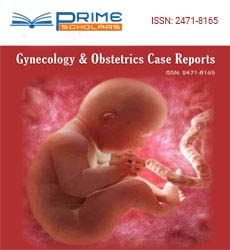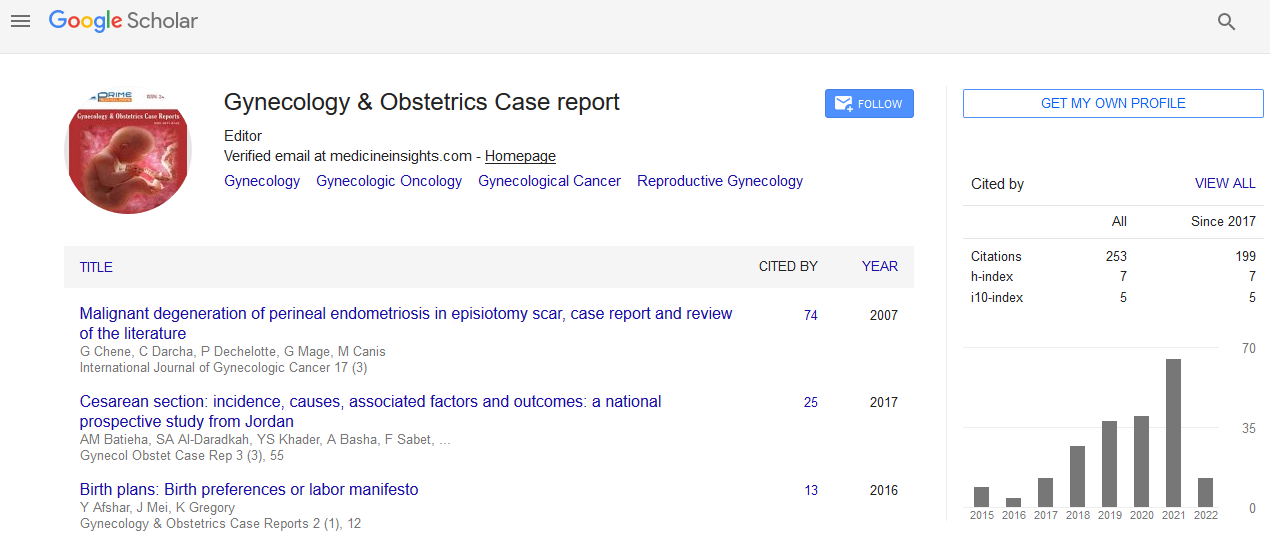Case Report - (2025) Volume 11, Issue 2
Approach In Pregnancy Complicated With Early Stage Of Cervical Cancer: A Case Report
Kristian Alda1,
M Adya F Dilmy2* and
Hariyono Winarto3
1Department of Obstetrics and Gynecology, Faculty of Medicine Universitas Indonesia, Jakarta, Indonesia
2Fetomaternal Division, Department of Obstetrics and Gynecology, Faculty of Medicine Universitas Indonesia, Depok, Indonesia
3Oncology Division, Department of Obstetrics and Gynecology Faculty of Medicine Universitas Indonesia, Depok, Indonesia
*Correspondence:
M Adya F Dilmy, Fetomaternal Division, Department of Obstetrics and Gynecology, Faculty of Medicine Universitas Indonesia, Depok,
Indonesia,
Email:
Received: 18-Jul-2025, Manuscript No. IPGOCR-25-22750;
Editor assigned: 21-Jul-2025, Pre QC No. IPGOCR-25-22750 (PQ);
Reviewed: 04-Aug-2025, QC No. IPGOCR-25-22750;
Revised: 11-Aug-2025, Manuscript No. IPGOCR-25-22750 (R);
Published:
18-Aug-2025, DOI: 10.36648/2471-8165.11.275
Abstract
Cervical cancer is one of the most common malignancies affecting women worldwide, but its occurrence during pregnancy remains rare, affecting only 1%-3% of pregnant women. Managing cervical cancer in pregnancy poses significant clinical and ethical challenges, as treatment must balance maternal oncologic outcomes with fetal safety. We report a case of a 38-year-old woman, gravida 3 para 2, diagnosed with stage IB1 cervical squamous cell carcinoma at 30 weeks of gestation, who presented with postcoital bleeding and lower abdominal pain. Clinical, ultrasound, and MRI assessments revealed a 2 cm cervical mass without evidence of local invasion or lymphadenopathy. Histopathology confirmed moderately differentiated non-keratinizing squamous cell carcinoma. Respecting the patient’s strong desire to continue the pregnancy, a multidisciplinary team opted for delayed treatment. After fetal lung maturation, cesarean section was performed at 36 weeks followed by radical hysterectomy with left salpingo-oophorectomy and right ovarian transposition. The neonate, delivered with transient respiratory complications, was managed in the neonatal intensive care unit. Postoperative recovery was stable, and adjuvant chemoradiation was planned. This case highlights the importance of individualized care, taking into account gestational age, tumor characteristics, and patient preferences. In select early-stage cervical cancer cases, deferred definitive treatment until fetal maturity followed by radical surgery may offer favorable outcomes for both mother and fetus.
Keywords
Cervical cancer; Pregnancy; Stage IB1, Cesarean section, Radical hysterectomy; Squamous cell carcinoma
Introduction
Cervical cancer is the one of the most common malignancies in woman, with approximately 604,000 new cases globally [1]. About 85% of all cervical cancers occurred in developing countries. Mortality was seen in 200,000 cases [2].
Cervical cancer complicating pregnancy is uncommon. The incidence was relatively low, with only 1%-3% cases were diagnosed during pregnancy or postpartum. The role of pregnancy in cervical progression was still controversial, as some had reported the indirect effect of hormonal levels during pregnancy (i.e., estrogen, progesterone, and human chorionic gonadotropin) on Human Papillomavirus (HPV) infection [3, 4]. Another study also suggested that lymphatic and blood flow compromise in pregnancy may accelerate the progression of tumor and cervical cancer development [5].
Treatment in pregnancy complicated with cervical cancer was challenging. Primarily, it depended on patient’s will whether to maintain or terminate her pregnancy. Choices of treatment (e.g., chemotherapy) were also limited due to fetal risk [6, 7]. In this case report, we presented a case of pregnancy complicated with early stage of cervical cancer (IB1) in patients who desired to continue her pregnancy.
Case Presentation
A 38-year-old female arrived at our settings with a chief complain of postcoital bleeding since 8 months before admission. There was also intermittent lower abdominal pain. Patient was currently in her G3P2, 30 weeks pregnancy. General examination and vital signs were within normal limits. Gynecological examination showed exophytic mass sized 2 × 2 × 2 cm, which bleeds easily (Figure 1). Mass was palpated in the portio of the cervix. Digital Rectal Examination (DRE) did not reveal any mass in intraluminal area.
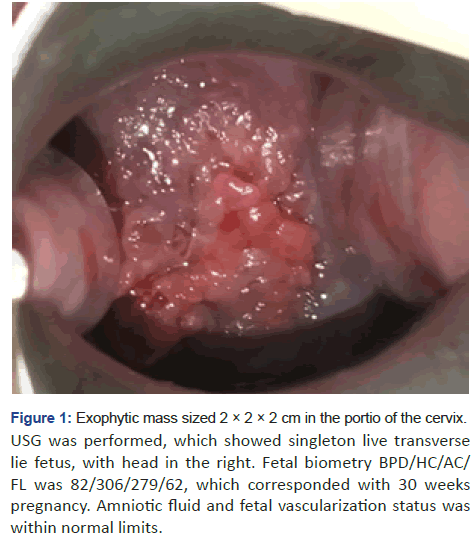
Figure 1: Exophytic mass sized 2 × 2 × 2 cm in the portio of the cervix. USG was performed, which showed singleton live transverse lie fetus, with head in the right. Fetal biometry BPD/HC/AC/ FL was 82/306/279/62, which corresponded with 30 weeks pregnancy. Amniotic fluid and fetal vascularization status was within normal limits.
Gynecological USG was also performed to evaluate the pathological mass, which showed a pathological mass in cervix, hypo-hyperechoic, measuring 2.31 × 1.53 × 1.71 cm with a volume of 3.16 cc. The mass did not appear to infiltrate adjacent myometrium or bilateral parametrium. There was also no infiltration to bladder or rectum (Figure 2). Left and right ovaries were difficult to visualize, with no enlargement of bilateral pelvic lymph node. There was no visible free fluid in the pelvic area.
Patient underwent whole abdominal non-contrast MRI and further biopsy examination. T2W and STIR MRI revealed hyperintense lesion in posterior uterine cervix mucosa with faint diffuse restriction. No infiltration was seen to adjacent tissues (Figure 2). Histopathological examination was performed, which showed papillary squamous cell carcinoma with moderate differentiation in the cervix. There was no lymphovascular invasion found.
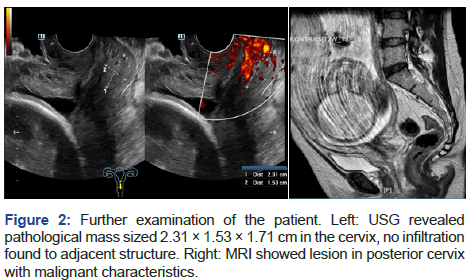
Figure 2: Further examination of the patient. Left: USG revealed pathological mass sized 2.31 × 1.53 × 1.71 cm in the cervix, no infiltration found to adjacent structure. Right: MRI showed lesion in posterior cervixwith malignant characteristics.
Radical hysterectomy with left salphingo-oophorecomy, right salpingectomy, and right ovarian transposition was performed (Figure 3). Patient was stable postoperatively. A 2060-grams, 40 cm baby boy was born with Apgar score of 5/7. Baby was diagnosed with respiratory distress syndrome with differential diagnosis of transient tachypnea of newborn, currently on ventilator mode PC/AC PEEP 6 FiO2 20%.
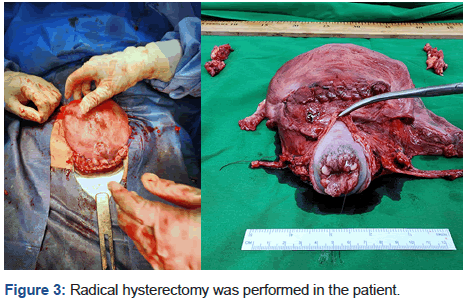
Figure 3: Radical hysterectomy was performed in the patient.
Results and Discussion
This case report presented a case of pregnancy complicated with early-stage cervical cancer. Treatment of cervical cancer in pregnancy was challenging, as the choice of treatments were limited, and patients’ will played an important role in deciding treatment choice [7]. Pregnant patients with cervical cancer also may present with atypical and non-obvious symptoms. Clinical manifestations in cervical cancer may involve vaginal discharge with purulent or bloody secretions, irregular bleeding, or postcoital bleeding (in 3%-5% patients) [8]. Some also presented with pain or fatigue due to long-standing chronic anemia, which may mimic common conditions in pregnancy or other diseases [4].
In our patient, preservation of pregnancy was sought in accordance with patient’s will. There were several factors that may influence the decision of continuation or termination of pregnancy: Histological subtype, nodal status metastasis, imaging assessment (MRI), stage of cancer, gestational age, and presence of other obstetric complications [6,7,9].
Termination of pregnancy has been widely chosen as more aggressive treatment can be sought in non-pregnant patients with cervical cancer. Progression of cancer in pregnancy had been related to increased level of estradiol during pregnancy, which were associated with HPV infection and subsequent tumor development [10]. In addition, imbalance in maternal immunity during pregnancy (i.e., inhibition in Th1 pathway with enhancement in T-reg) may increase immune tolerance responsible for cancer progression [11]. However, despite some studies reported the risk of cervical cancer progression in continuation of pregnancy, the effect was rather controversial. For instance, study conducted by Haie-Meder et al. reported that an average delay of 16 weeks treatment in stage IB1 or higher cervical cancer due to pregnancy continuation resulted in 95% survival rate, which did not significantly differ with pregnancy termination [12]. In contrast, Ma, et al. showed that Disease-Specific Survival (DSS) was significantly lower in those who delayed treatment due to pregnancy compared to patients who received immediate treatment (5-year DSS 61% vs. 86%; p<0.05) [13]. Prognostic factors such as tumor size (>2 cm) and lymph node metastasis were associated with worse prognosis [14].
In patients with stage IA1 or IA2, conization can be performed preferably between 14-22 weeks pregnancy. Caution needed to be taken not to incise too deep, as it may damage fetal membranes and compromised pregnancy. Conization can be combined with cervical cerclage to prevent premature labor and bleeding [15,16]. In higher stage, such as IB1 in our patients, radical hysterectomy with pelvic node dissection (in patients with positive lymph node) was recommended as it was associated with high 5-year survival rate [17]. Extent of radical hysterectomy can be chosen accordingly based on each patient’s tumor status (i.e., tumor size, presence of Lymph-Vascular Space Invasion (LVSI), and depth of invasion) [18].
It needed to be highlighted that despite patient’s will to continue her pregnancy, premature delivery may be inevitable due to cancer progression. Delivery with caesarean section was recommended as vaginal delivery was associated with increased risk of bleeding and tumor metastasis. Neoadjuvant chemotherapy can be administered after 20 weeks gestational age as it may result in spontaneous abortion or fetal anomaly if given early [4]. However, in patients without lymph node involvement, treatment can be safely delayed until 34-35 weeks to allow full-term delivery [16]. In our patient, full-term delivery was sought to optimize patient and fetal outcomes, with radical hysterectomy performed after caesarean section. Patient was stable postoperatively.
Conclusion
Management of pregnancy complicated with cervical cancer was challenging. Several factors, such as tumor size, lymph node involvement, tumor stage, gestational age, and patient’s will may influence the choice of treatment. If the patient desired to continue her pregnancy, such as in our patient, delayed cancer treatment until full-term delivery can be sought followed by radical hysterectomy and subsequent chemotherapy planning.
References
- Sung H, Ferlay J, Siegel RL, Laversanne M, Soerjomataram I, et al. (2021) Global cancer statistics 2020: GLOBOCAN estimates of incidence and mortality worldwide for 36 cancers in 185 countries. CA Cancer J Clin. 71(3):209-249.
[Crossref] [Google Scholar] [PubMed]
- Vali M, Maleki Z, Nikbakht HA, Hassanipour S, Kouhi A, et al. (2023) Survival rate of cervical cancer in Asian countries: A systematic review and meta-analysis. BMC Womens Health. 23(1):671.
[Crossref] [Google Scholar] [PubMed]
- Shiping Z, Lushan ZQ (2018) Progress in diagnosis and treatment of pregnancy complicated with cervical cancer. J Pract Med. 25(4):400-402.
[Google Scholar]
- Beharee N, Shi Z, Wu D, Wang J (2019) Diagnosis and treatment of cervical cancer in pregnant women. Cancer Med. 8(12):5425-5430.
[Crossref] [Google Scholar] [PubMed]
- Meihao OG (2008) The effect of pregnancy with cervical cancer on mother and child and the principle of diagnosis and treatment. Adv Modern Obstetr Gynecol. 17(1):64-66.]
[Google Scholar]
- He Z, Xie C, Qi X, Hu Z, He Y (2022) The effect of preserving pregnancy in cervical cancer diagnosed during pregnancy: A retrospective study. BMC Womens Health. 22(1):314.
[Crossref] [Google Scholar] [PubMed]
- Han SN, Mhallem Gziri M, Van Calsteren K, Amant F (2013) Cervical cancer in pregnant women: treat, wait or interrupt? Assessment of current clinical guidelines, innovations and controversies. Ther Adv Med Oncol. 5(4):211-219.
[Crossref] [Google Scholar] [PubMed]
- Ardestani S, Dason ES, Sobel M (2023) Postcoital bleeding. Can Med Assoc J. 195(35):E1180.
- Lihui W, Yun Z, Xing X (2018) Expert consensus on the management of cervical cancer in pregnancy. Chinese J Obstetr Gynecol. 19(2):190-192.
[Google Scholar]
- Le Guevelou J, Lebars S, Kammerer E, de Gabory L, Vergez S, et al. (2019) Head and neck cancer during pregnancy. Head Neck. 41(10):3719-3732.
[Crossref] [Google Scholar] [PubMed]
- Lin W, Niu Z, Zhang H, Kong Y, Wang Z, et al. (2019) Imbalance of Th1/Th2 and Th17/Treg during the development of uterine cervical cancer. Int J Clin Exp Pathol. 12(9):3604.
[Google Scholar] [PubMed]
- PityÅ?ski K (2013) Gynaecological cancers in pregnancy. Ginekol i Poloznictwo. 28(2):9-18.
- Ma J, Yu L, Xu F, Yi H, Wei W, et al. (2019) Treatment and clinical outcomes of cervical cancer during pregnancy. Annals of translational medicine. 7(11):241.
[Crossref] [Google Scholar] [PubMed]
- Amant F, Halaska MJ, Fumagalli M, Steffensen KD, Lok C, et al. (2014) Gynecologic cancers in pregnancy: Guidelines of a second international consensus meeting. Int J Gynecol Cancer. 24(3):394-403.
[Crossref] [Google Scholar] [PubMed]
- Morice P, Uzan C, Gouy S, Verschraegen C, Haie-Meder C. (2012) Gynaecological cancers in pregnancy. Lancet. 379(9815):558-69.
[Crossref] [Google Scholar] [PubMed]
- Cintra GF, Derchain SF, Bicalho DS, Filho ALS, Primo WQ. (2023) Cervical cancer in pregnancy. Revista Brasileira de Ginecologia e Obstetrícia. 45(5):293-6.
[Crossref] [Google Scholar] [PubMed]
- Wijeratne Y, Hapuachchige C. (2023) Surgical outcomes in early-stage cervical cancer following radical hysterectomy in a resource-limited setting: the experience of the national cancer institute (Apeksha hospital, maharagama), Sri Lanka. Cureus. 15(10):1-9.
[Crossref] [Google Scholar] [PubMed]
- Bianchi T, Grassi T, Bazzurini L, Di Martino G, Negri S, et al. (2023) Radical hysterectomy in early-stage cervical cancer: abandoning the one-fits-all concept. J Pers Med. 13(9):1292.
[Crossref] [Google Scholar] [PubMed]
Citation: Alda K, Dilmy MAF, Winarto H. Approach in Pregnancy Complicated with Early Stage of Cervical Cancer: A Case Report. Gynecol Obstet Case Rep. (2025) 11:275.
Copyright: © Alda K, et al. This is an open-access article distributed under the terms of the Creative Commons Attribution License, which permits unrestricted use, distribution, and reproduction in any medium, provided the original author and source are credited.
